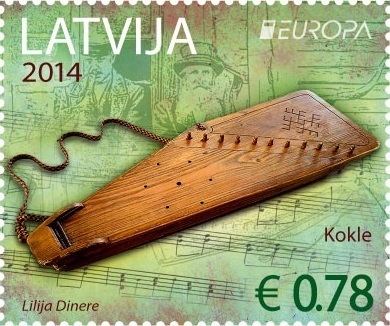Other names Kūkle (Latgale) | ||
 | ||
Classification Plucked string instrument, chordophone Hornbostel–Sachs classification 314.122(Diatonic lute-type stringed instrument) | ||
Kokle (['kʊ͡ɔk.le]; Latgalian: kūkle) is a Latvian plucked string musical instrument (chordophone) belonging to the Baltic zither family known as the Baltic psaltery. The first possible kokle related archeological findings in the territory of modern Latvia are from the 13th century, while the first reliable written information about kokle playing comes from the beginning of the 17th century,. The first known kokle tune was notated in 1891, but the first kokle recordings into gramophone records and movies were made in 1930s. Both kokle and kokle playing are included in the Latvian Cultural Canon.
Contents
Origin
The Baltic tribes developed the kokle based on similar zithers played by the Finnic and Slavic peoples of the region. Legendarily, the strings of the kokle were said to represent the sun. The first reliable written information about kokle playing is from the beginning of 17th century. A kokle at the Historical Museum in Riga shows Latvian runes.
Construction
The kokle has a hollow trapezoidal body usually carved out of a single piece of wood that's topped with a thin ornated wooden soundboard. Wooden tuning pegs are set into the wide tip of the body, while at the narrow tip is a metal rod upon which the strings are secured. The strings may be of brass or steel. Traditionally, there were 6-9 strings which later increased to 10 and more.
Playing
The player generally plays the instrument sitting at a table, strumming with his right hand and muting unwanted strings with his left hand. The kokle is generally tuned in a diatonic scale, with some lower strings functioning as bourdons (drones) which continuously sound.
Kurzeme kokle
In the Latvian historical region of Kurzeme, kokles are traditionally constructed smaller in size and without a "wing", but with more ornate carvings and ornaments. It also usually has fewer strings than Latgale kokle, ranging from 5 to 6 stings for the ones found at the west coast of Kurzeme and Selonia to 7, 8 or even 9 strings for the suiti inhabited areas.
On May 17, 2015, during Latvia's presidency of the Council of the European Union, a Kurzemes kokle built by the crafter Jānis Rozenbergs was donated to the Musical Instruments Museum of Brussels.
Latgale kokle
In the largely Catholic Latgale region of Latvia, it was characteristic for the kokle to be constructed with an extension of the body beyond the peg line called a wing, that reinforces instrument's the sound and can also be used as an arm support. Compared with Kurzemes kokles, the finish is less thorough; the instruments are bigger, and heavier, with more sober decoration. As previously mentioned, Latgale kokles have more strings than Kurzeme kokles; sometimes even up to 12 and only in rare cases less than 9.
In the Augšzeme and Vidzeme districts of Latvia both types of kokle, as well as mixed forms (for example, kokles with beak-shaped wings) were played.
Zither kokle
At the end of the 19th century and the beginning of 20th century kokle traditions were influenced by the construction and playing style of the Western zithers coming from Germany and other Central European countries. Thus arose the so-called zither kokles: kokles with larger, zither-type cases, steel tuning pins, and an increased number of strings (from 17 to sometimes even up to 30 single or double strings).
Concert kokle
The first larger "concert kokle" with a three-and-a-half octave range and 25 stings was constructed in 1951 by Romāns Ķirpis for the Latvian folk music orchestra's soloist Helēna Kļava-Birgmeistere. It was the first to have devices to change the pitches of strings in order to change keys. Few years later concert kokle saw a few more innovations in the construction and the new design gradually spread in the Latvian Conservatoire and musical schools, as well as amateur kokle ensembles.
In modern music
Alliage III by the Danish composer Niels Rosing-Schow uses two kokles tuned a quarter-tone apart along with violin, cello, and accordion.
The Kokle is demonstrated as a folk instrument by the Latvian National Kokle collective Teiksma, Koklētāju Ansambļiem (The Legends Harpers Ensemble) performing in Latvia and at the Latvian song festival held in the nations of the Latvian diaspora. The Teiksma folk musicians are associated with the Folk Music Department of the Latvian Academy of Music. Founded by Tamara Jansone in 1955, the Latvian national Kokle ensemble played its 50th anniversary concert in 2005 and is headed by Teiksma Jansone, the school is located in Kronvalds Boulevard 8, Riga.
An Australia-based Latvian folk music group, Zigrīda Ansamblis uses the kokle in their performances.
In 2002 record label Upe released a double CD by ethnomusicologist Valdis Muktupāvels titled "Kokles". The first disc "Muktukokles" contained 9 Muktupāvels' original kokle compositions and 2 arrangements of traditional songs accompanied by other instruments (sarod, tambura, and tabla), as well as the vocals of Rūta Muktupāvele, while the second disc "Tradicionālās kokles" contained 24 Kurzeme, suiti and Latgale traditional tunes and dance melodies.
In 2016 record label Lauska released a CD Trejdeviņi koklētāji (Thrice-nine kokle players) featuring some of the best known Latvian kokle players (Valdis Muktupāvels, Laima Jansone, Biruta Ozoliņa and Ansis Jansons among others) and Baltic psaltery players from abroad (Leanne Barbo from Estonia and Jenni Venäläinen from Finland), as well as Latvian concert kokle ensembles, and a collection of 13 compositions that span from traditional to ethno-jazz and ethno-baroque genres. A bilingual Latvian-English hardback booklet was also included with notes on performing musicians and their compositions, as well as a brief history of kokle.
